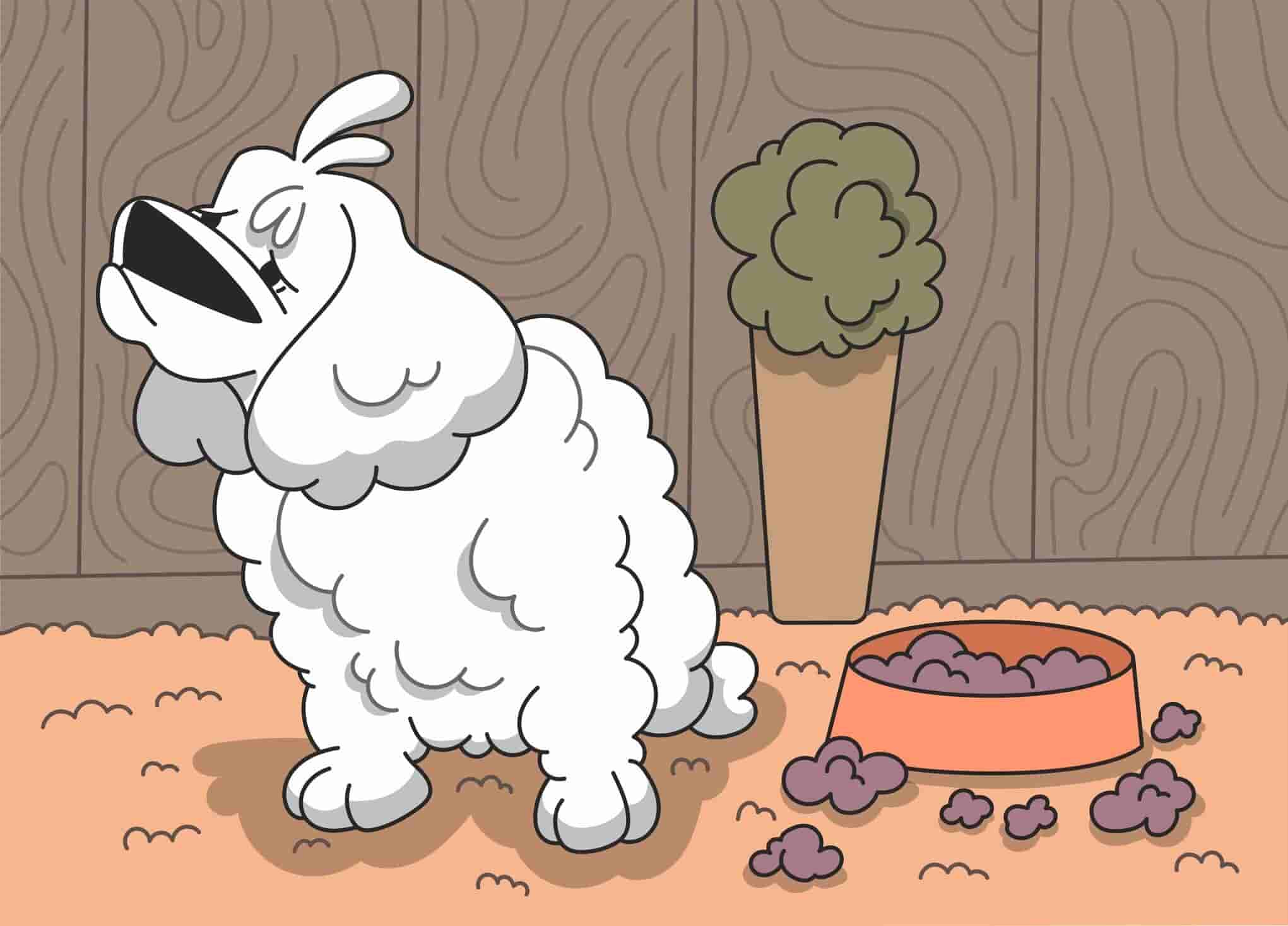Are your dogs not eating their food anymore even though they used to down it the minute it was in the bowl? There are many reasons why a dog doesn’t want to eat. The causes can range from misbehavior to serious health issues but a dog refusing food requires action. Here are a few things you can do.
Stop Googling - Ask a Real Vet
Contents
How to find out | Common reasons | Best solutions | New puppies | Water Intake | FAQs
Why Won't My Dog Eat
The loss of appetite in dogs is called inappetence or anorexia. Anorexia in dogs is not the same condition as anorexia in humans. Doggy anorexia can be partial or complete. If your dog is only eating some types of food, but not enough to stay healthy, it’s partial anorexia. If your dog won’t eat anything at all, you’re dealing with complete dog anorexia. Pseudo-anorexia in dogs is a condition when a dog wants to eat but can’t because of another problem.
First, you need to determine the causes of why your dog won’t eat, and here is how to do it.
5 steps to find out why your dog is not eating
If it’s been two days or more since your pooch ate, take it seriously and determine the reasons why your dog won’t eat.
- Observe your dog's behavior
- Check the teeth and body of your pooch
- See if there are any issues with the food
- Check the environment
- Re-examine your actions
Step 1 - Observe the dog’s behavior
When observing the dog’s behavior, check if your dog won’t eat anything or won’t eat some type(s) of food. You can monitor your pet’s food intake remotely through Petcube Cam in case you are away.
See if your dog is behaving as usual or there are other changes in the daily routine. Also, pay attention to the dog's stool and urine. If all is normal, you can let your pet skip a meal or two. If your pet's condition is critical and they are vomiting, have diarrhea or are lethargic and hydrated, you may need to get emergency help.
In this case, a subscription to Petcube Emergency Fund will come in handy. Subscribing to this alternative pet insurance costs less than $1/day for all your pets and you can have peace of mind in case of an emergency. Pet Emergency Fund will help cover your bills. If you are not sure whether you need emergency care, a certified veterinarian will be able to advise you at any time of the day. This service is also included in the subscription.
If apart from reduced appetite, your pooch is hiding, sleeping all day, or losing interest in play and other usual activities, it can be a sign of dog depression.
Step 2 - Check your dog’s teeth and body
If you notice broken, loose or bad teeth, or inflamed gums, this can be a cause behind why your dog is not eating. When checking your pet’s body, look for parasites, changes in their fur and skin, and any lumps or injuries. If you find something suspicious, don’t hesitate to call a vet.
Step 3 - Check for issues with the food
If your dog won’t eat the food, make sure there isn’t anything wrong with it. Check the label for the expiry date, check the color and smell. If you suspect the food is spoiled, get rid of it and offer your dog something else.
Step 4 - Check the environment
If your dog stopped eating, it might be because of eating something dogs shouldn’t have. Check your houseplants, carpets, pet's toys, and any items your four-legged friend has access to. Be extra careful if there are medications or chemicals within your dog’s reach. If anything is missing, and your dog is vomiting or has diarrhea, consult a vet right away.
If your puppy or a new dog won’t eat, maybe it’s due to a new environment. The same goes if you have moved recently.
If your pet has been spending time with other people during the day, find out if someone has already fed your dog.
Step 5 - Examine your actions
Have you been giving your dog a lot of treats or table scraps? If you have, it can explain the loss of appetite. Or maybe your dog is just waiting for something tastier — like chunks of your dinner or doggy treats.
Common Reasons For Loss Of Appetite In Dogs
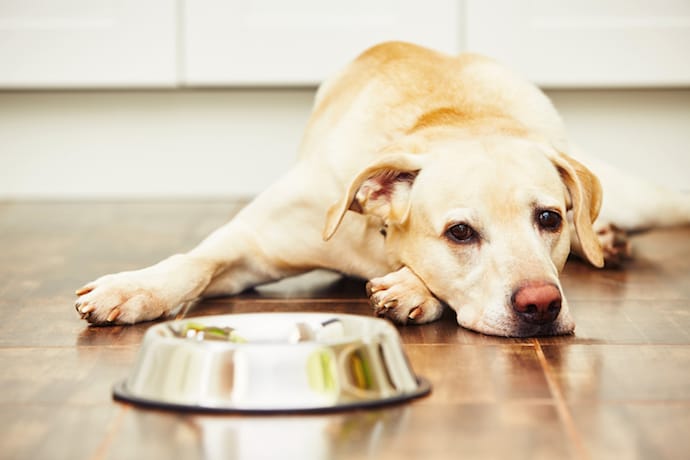
The list of reasons for loss of appetite in dogs is long. It includes medical issues, behavioral problems, environmental problems, separation anxiety, and problems with the food itself.
Medical conditions
Medical conditions that can cause a loss of appetite in dogs include:
- Upset stomach
- Poisoning
- Allergies
- Depression
- Infection
- Pain
- Problems with teeth, gums, or tongue
- Tumors
- Parasites
- Autoimmune diseases and neurological diseases
- Problems with internal organs (heart, liver, kidneys, lungs)
- Recent vaccination
Behavioral and environmental reasons
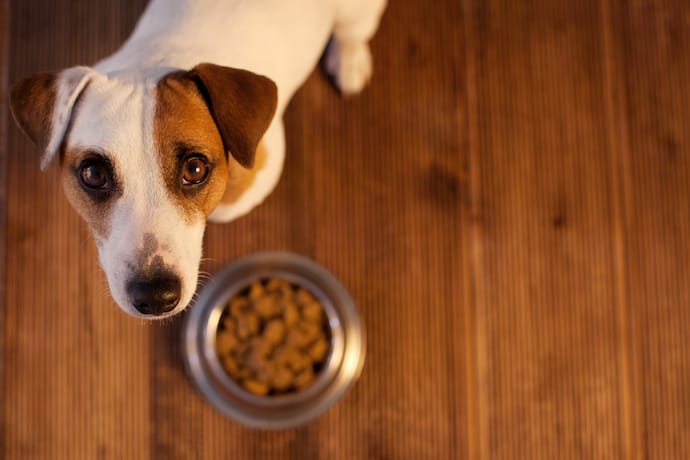
Behavioral reasons are separation anxiety, your dog is used to getting lots of treats and table scraps, your dog likes to eat alone or only when there’s someone else in the room, or your pooch is used to being hand-fed.
Changes in the environment include a recent move or traveling, absence of a family member or another pet, weather changes, recent stress, or a change in the feeding schedule.
My dog refused to eat for two and a half days when she got a new food bowl. Maybe it’s a dachshund thing. The point is, you should consider every change in the environment and habits.
What to do? - Read about ↓ Treating environmental and behavioral loss of appetite in dogs
Dog Separation Anxiety
Is your dog not eating when left home alone? One reason could be separation anxiety. Keep tabs on your pet’s behavior with Petcube pet cam. If your furry friend goes crazy when left alone, you should learn about ways to treat separation anxiety. Another reason can be that the dog feels the need to guard the house until you get back. So, there’s no time to eat.
Of course, it’s possible that your dog is just not used to eating when left alone at home — or feels a little bit sad when you’re gone.
What to do? - Learn about → How to treat separation anxiety in dogs
Food issues and diet changes
Does your dog usually can't wait to eat, but now they are turning their nose away from food? If your pet refuses to eat, he may have some food issues.
First of all, check if the food is spoiled or if something inedible got on the plate. If it is not, remember if you have changed the dog's diet recently. Did you buy new food? Have new products been introduced into the diet?
Also, these issues can arise as a result of changing the diet from homemade food or wet dog food to kibble. Any change in diet can be stressful for your fur kid, so they may refuse to eat. Be careful and introduce new meals gradually.
Another thing you should pay attention to is the food’s ingredients. If your dog is sensitive to one or more of them, they may not touch the plate. It is possible that you have a picky pet or that you are overfeeding your dog.
In this case, the vet can help you make a universal menu and choose the exact amount of food for your dog. Also, think about the temperature of the food you are serving. If it’s too cold or too hot, dogs can skip dinner.
The last one, eating the same food for a long time, is also not good. Just like people, dogs want to eat something new and tasty. Therefore, if your dog is on strike against food, it may mean that he is bored with it. I bet you wouldn't want to eat the same food for a month either.
What to do? - Read about ↓ Solving food-related loss of appetite in dogs
Solutions For Loss of Appetite in Dogs
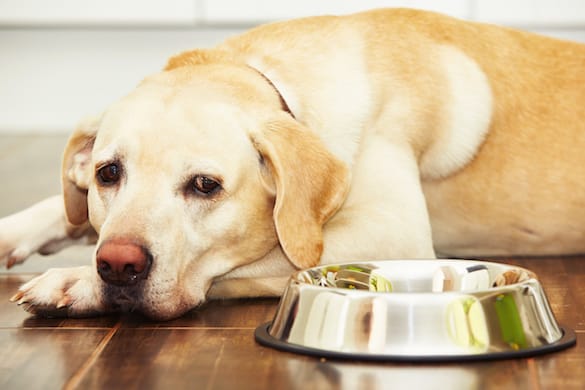
For medical issues, consult a vet. Otherwise, things can go very wrong very fast.
Solving Food-Related Loss Of Appetite In Dogs
When it comes to food-related reasons for a loss of appetite in dogs, some solutions can be quite simple to implement.
| Food Reasons | Solutions |
|---|---|
| New food | Switch gradually to new food/go back to old food |
| Low quality food | Try to get better quality food |
| Different food taste/smell | Find out which taste and smell your dog likes |
| Less/more fatty food | When switching food, choose an option with similar nutritional value |
| Switch from home-cooked food to kibble or other pet food | Mix new food with home-cooked food and slowly make the transition or go back to home-cooked food if possible |
| Kibble without dressing | Add dressing over kibble and mix it up |
| Spoiled food | Always check the expiration date before giving it to your pet |
| Sensitive to a food ingredient | Choose food without the ingredient your dog is sensitive to |
| Same food for a long time/dog is bored | Mix things up every once in a while |
| Hot/cold food | Make sure the food is the right temperature for your dog |
Treating Environmental And Behavioral Loss Of Appetite In Dogs
When it comes to behavioral and environmental reasons your dog won’t eat, the process can be a little more stressful and time-consuming. Sometimes, you may need to consult a pet behavior expert or a trainer.
Here are some general tips for getting your dog to eat regularly:
- Get your pet enough exercise and attention
- Invest some time and/or money in training
- Don’t punish your dog for not eating, be patient and supportive
- Only give treats as a reward
- Avoid giving table scraps
New Puppy Won't Eat
Puppies are usually crazy about food and will eat anything and everything. If your new puppy won’t eat, be patient, and try different types of food. Just like the puppies are new to you, they are with new people, in a new environment, and introduced to new types of food.
Here’s what you can do when your new puppy won’t eat:
- Make sure there’s no medical issue
- Try different types of food
- Don’t give too many treats
- Take the puppy out for regular walks
- Establish a feeding schedule
- Fill a toy with food
- Change where you’re putting the food bowl
- Figure out if the puppy prefers you being present or away during feeding
Bonus Tip: Monitor Water Intake When Your Dog Won’t Eat
When your dog won’t eat, it’s important to monitor the water intake. Dogs shouldn’t even go a day without drinking water. Your pooch should drink at least an ounce of water per pound of weight every day to prevent dehydration. If you notice your dog isn’t drinking, it’s wise to get to a vet sooner rather than later as dehydration can set in.
Your Dog Won’t Eat But Drinks Water
If your dog won’t eat but drinks water, give it a day or two. It’s possible that your pet merely has an upset stomach. If you notice other issues in behavior, you should call a vet.
Perhaps your pooch got into the trash and ate something that isn’t agreeing with him, perhaps he ate a bug, or maybe just ran around too much. Avoid giving your dog treats at this time, but rather wait until they are ready to eat their actual food.
Dog Not Eating and Drinking
Your dog not eating and drinking water is a serious issue. There can be a medical problem and you should take your pooch to a vet. Check for signs of dehydration, as well as vomiting and diarrhea. If all three are present, consider it an emergency.
If the lack of appetite is accompanied by other digestive issues like vomiting and diarrhea it may be a sign of an infection or disorder that requires a vet’s attention. A dog not eating but drinking water and vomiting may have a more serious infection.
Most digestive issues will clear up in a few days but if they don’t seem to be improving, make sure to get to the vet as soon as possible.
Your Dog Eats But Won't Drink Water
If your dog eats but won’t drink water, it might be diabetes, a bladder infection, urinary tract infection, or kidney disease. These conditions call for a veterinary visit.
But if you gave your buddy some soup with the meal, this might be a reason for not drinking water.
FAQs
How long can a dog go without eating?
Most dogs can go three to five days without food, while in some cases they can survive seven days or more. However, if your dog won’t eat for more than two days, we recommend that you talk to a vet.
A bigger issue is water intake. Dogs can go far less without water than without food. While a dog MIGHT survive for up to 2-3 days without water, don’t try it! If you notice that your pet hasn’t been drinking water all day, check for dehydration and consult a vet ASAP!
How do you stimulate a dog's appetite?
You can naturally stimulate a dog’s appetite, or you can use pharmaceuticals. You should only do this after consulting a vet. Natural options include offering your pup's favorite food, rotisserie chicken, or trying acupuncture.
What can I feed my sick dog that won’t eat?
If your dog is sick and won’t eat, it’s tempting to want to force them to eat. But how do you get your sick dog to eat?
First off, if your dog isn’t eating, give it some time. Your dog will be ok if it misses a meal or two, as long as it’s still drinking water. It could be something simple like indigestion that will pass quickly.
If it doesn’t pass, you can try encouraging your pooch to eat by making the food irresistible. Add a treat to their normal food or heat up the food to release those delicious aromas – these also help when you need to sneak in some medication.
For feeding a sick dog that won’t eat, most vets recommend bland chicken with white rice or white meat from a rotisserie chicken. Other options are sweet potatoes, unseasoned pumpkin (not pumpkin pie filling!), bone broth, and meat-based baby food.
Lastly, you can try hand-feeding your sick dog. This can be very comforting to them and will help get them to at least take in a little food until they feel better.
My dog isn’t eating but acting normal
If your dog isn’t eating but is acting normal and drinking water, you can wait it out. Sometimes a dog's loss of appetite is the result of weather changes. If this lasts longer than two days, you should consider other reasons.
Why is my dog not eating and drinking a lot of water?
If you think your dog is drinking too much water, talk to a vet. Excessive drinking is usually caused by medical conditions. It can be kidney failure, diabetes, Cushing's disease, Addison’s disease, liver disease, infection, or hypercalcemia.
How to force-feed a dog?
If your dog won’t eat, don’t try to shove kibble down their throat. If you must force-feed a dog to stimulate their appetite, take some baby food, and smear it on the dog's lips.
Some people force-feed their pets using a syringe without a needle. Be careful and only inject small portions of food at a time into your dog’s mouth. Let the dog swallow it instead of spraying it into the throat.
Why won't my dog eat food but will eat treats?
Chances are, your furbaby is spoiled or picky. Some dogs are skipping meals and waiting for treats because they just prefer the taste of treats.
Treats are delicious and can be a handy way to reward and praise your precious pooch. When given too liberally, however, treats can become far more appealing than actual food, causing some dogs to turn their nose up at their regular food and demand only treats.
It might also be that your pup is bored with their food or doesn’t much like it. In these cases, it might be time to look at a new brand of food. Aim for the best quality you can afford, and maybe drizzle some warm water over it to release those tempting odors.
How can I get a picky dog to eat their food?
There are many ways to get picky dogs to eat their food. Try one of the following:
- Give highly palatable and nutritious food
- Make sure the food smells right
- If you’re feeding your dog kibble, add some warm water, bone broth, or wet food
- Offer home-cooked food
- Cut down on treats and avoid feeding off the table
- Praise the dog for eating the food
- Take your pet for a walk or a run before feeding time
Why won’t my dog eat in the morning?
If your dog won’t eat in the morning but will eat later in the day, it could be due to many factors. It may be the bustle of a busy house in the mornings makes your dog anxious or simply that there’s too much going to focus on food.
Free-feeding is often a cause of dogs turning up their nose to their morning meal. This is because your dog has gotten used to having access to food all day and so can eat whenever they wish.
Unfortunately with free-feeding, the food sits out for a lot longer, losing its tempting aroma, not to mention ants and bugs that come to the party for their fair share.
Try taking your dog for a walk first to stimulate their appetite. Try to stick to a fixed meal schedule and avoid free feeding.
My dog is old and no longer wants to eat. What should I do?
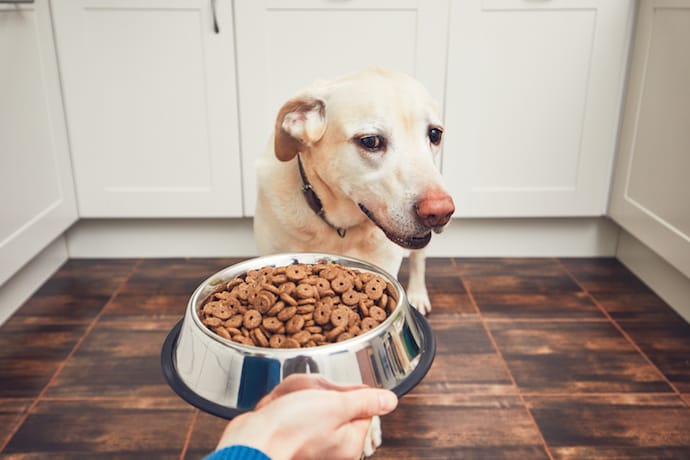
An old dog that won’t eat is a worrying thing. Remember that as your dog ages, his dietary needs will change. Make sure that you review your pooches chow to match its phase of life and changing digestion. Your dog might eat less now in its later years than it did when it was younger and more energetic.
Oftentimes, the reason for older dogs not eating is due to dental issues. Get a good dental check-up on your senior dog to make sure they’re not suffering or in any pain that it’s causing them to avoid eating. Add more moisture to dry food too, so it’s softer and needs less aggressive chewing.
Of course, be on the lookout for any symptoms that may indicate a more serious problem, and don’t delay in getting it checked out by a vet.
Dog not eating after surgery or vaccination
Surgery like spaying and neutering commonly results in dogs not eating for a day or two. Often the anaesthetic causes nausea so your pooch may skip a meal or two, which is totally normal and nothing to worry about. A dog not eating after surgery is common and usually, the loss of appetite resolves within 24 hours. If not, call the vet.
Pain after a procedure can also cause your dog to lose interest in eating for a short time. If your dog is not eating at all after 24 hours, it’s best to check in with your vet.
Similarly, after your dog receives a vaccination, it’s common that it would lose its appetite. Let them rest and recover and if they’re not improving within 24 hours, contact your vet.
My dog is suddenly not eating its dry food
If your dog is suddenly very picky about its food, and you’ve ruled out any medical issues, perhaps consider spicing up their meals with some meal toppers to make them a bit more interesting and attractive?
If your dog won’t eat dry food anymore, add moisture to dry food with delicious and super nutritious bone broth or yogurt with active cultures to help with digestion. Other options include goat’s milk, unsweetened canned pumpkin, and other tasty fruits and veggies.
How to give medicine to a dog that won’t eat?
Giving medicine to a dog is a tricky business. While some dogs are more compliant than others, this is one element of pet ownership that can test the craftiness of most humans, made worse when the dog in question is refusing to eat, largely stripping you of all the sneaky hide-it-ham tricks you had up your sleeve.
Check out our helpful article on giving your dog a pill.
Was this article helpful?
Help us make our articles even better

